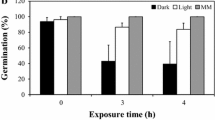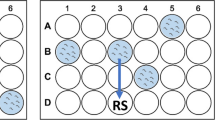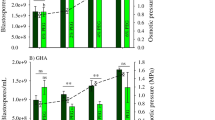Abstract
The effect of rapid and gradual exposure of entomopathogenic nematodes to osmotic stresses on the induction of a dormant state was determined with the nematodeSteinernema feltiae IS-6 infective juveniles (IJs). Rapid exposure of nematodes to glycerol at concentrations of 24% and 28% (w/w) caused the nematodes to enter a dormant state which was characterized by shrinking and impeded motility of all nematodes within 8 h. However, pre-exposure to gradually increasing glycerol concentrations of 5%, 10% and 18% at 4-h intervals resulted in dormancy after 4 h exposure to 24% glycerol. The total time of exposure to glycerol solution was 16 h in gradual osmotic stress. For nematodes exposed to 24% glycerol solution either rapidly or gradually, recovery occurred after 40 min in distilled water. Infectivity of osmotically stressedS. feltiae IJs was evaluated by two criteria, insect mortality and invasion rate. The assays indicated that infectivity of nematodes desiccated by rapid and gradual osmotic stresses was similar to that of fresh nematodes. Rapid exposure ofS. carpocapsae ‘All’,S. riobravis ‘Texas’,S. glaseri ‘NI’ andHeterorhabditis bacteriophora HP88 IJs to the 24% glycerol solution resulted in dormancy within 8 h. These treatments caused mortality of 48.4% and 11.7% amongS. glaseri Nl andH. bacteriophora HP88 IJs, respectively. Similar effects were observed when these nematode species were exposed to increasing osmotic stress of 5%, 10% and 18% at 6-h intervals. Under these same conditions, mortality ofH. bacteriophora HP88 andS. glaseri Nl IJs was 27.5% and 61.8%, respectively.
Similar content being viewed by others
References
Barrett, J. (1991) Anhydrobiotic nematodes.Agric. Zool. Rev. 4:161–176.
Behm, C.A. (1997) The role of trehalose in the physiology of nematodes.Int. J. Parasitol. 27:215–229.
Caroli, L., Glazer, I. and Gaugler, R. (1996) Entomopathogenic nematode infectivity assay: comparison of penetration rate into different hosts.Biocontrol Sci. Technol. 6:227–233.
Chen, S., Yang, H. and Jiang, S. (2000) Studies on the biochemical characters ofSteinernema carpocapsae BJ in anhydrobiosis.Acta Parasitol. Med. Entomol. Sin. 7:30–34.
Chen, S., Yang, H. and Jiang, S. (2001) Morphology and oxygen consumption of entomopathogenic nematodeSteinernema carpocapsae BJ in anhydrobiosis.Acta Entomol. Sin. 44:62–66.
Chen, S., Yang, H., Jiang, S., Jian, H. and Yang, X. (2001) Ultrastructure ofSteinernema carpocapsae BJ in anhydrous dormancy.Acta Zool. Sin. 47:442–446.
Cossins, A.R. and Bowler, K. (1987) Temperature Biology of Animals. Chapman & Hall, London, UK.
Crowe, J., Hoekstra, F.A. and Crowe, L.M. (1992) Anhydrobiosis.Annu. Rev. Physiol. 54:579–599.
Evans, A.A.F. (1987) Diapause in nematodes as a survival strategy.in: Veech, J.A. and Dickson, D.W. [Eds.] Vistas on Nematology. Society of Nematologists. Hyattsville, MD, USA. pp. 180–187.
Finnegan, M.M., Downes, J.D., O’Regan, M. and Griffin, C.T. (1999) Effect of salt and temperature stresses on the survival and infectivity ofHeterorhabditis spp. infective juveniles.Nematology 1:69–78.
Glazer, I. (2002) Survival biology.in: Gaugler, R. [Ed.] Entomopathogenic Nematology. CAB, London, UK. pp. 169–187.
Glazer, I., Liran, N. and Steinberger, Y. (1991) A survey of entomopathogenic nematodes (Rhabditida) in the Negev Desert.Phytoparasitica 19:291–300.
Glazer, I. and Salame, L. (2000) Osmotic survival of the entomopathogenic nematodeSteinernema carpocapsae.Biol. Control 18:251–257.
Kaya, H.K. (1990) Soil ecology.in: Gaugler, R. and Kaya, H.K. [Eds.] Entomopathogenic Nematodes in Biological Control. CRC Press, Boca Raton, FL, USA. pp. 93–115.
Kaya, H.K. and Stock, S.P. (1997) Techniques in insect nematology.in: Lacey, L. [Ed.] Manual of Techniques in Insect Pathology. Academic Press, San Diego, CA, USA. pp. 281–324.
Kung, S.P. and Gaugler, R. (1990) Soil type and entomopathogenic nematodes persistence.J. Invertebr. Pathol. 55:401–406.
Kung, S.P., Gaugler, R. and Kaya, H.K. (1991) Effects of soil temperature, moisture and relative humidity on entomopathogenic nematodes persistence.J. Invertebr. Pathol. 57:242–249.
Liu, Q. and Glazer, I. (2000) Desiccation survival of entomopathogenic nematodes of the genusHeterorhabditis.Phytoparasitica 28:331–340.
Liu, Q., Piggott, J., Solomon, A. and Glazer, I. (2002) Physiological and biochemical changes in nematodes of the genusHeterorhabditis following desiccation.Phytoparasitica 28:253–261.
Perry, R.N. (1998) Survival of terrestrial organisms.in: Glazer, I., Richardson, P., Boemare, N. and Coudert, F. [Eds.] Survival of Entomopathogenic Nematodes. European Commission Press, Warwick, UK. pp. 7–13.
Perry, R.N. (1999) Desiccation survival of parasitic nematodes.Parasitology 119:19–30.
Piggott, J.S., Perry, R.N. and Wright, D.J. (2000) Hypo-osmotic regulation in entomopathogenic nematodesSteinernema spp. andHeterorhabditis spp.Nematology 2:561–566.
Piggott, J.S., Qhi-Zhi, L., Glazer, I. and Wright, D.J. (2002) Does osmoregulatory behaviour in entomopathogenic nematodes predispose desiccation tolerance?Nematology 4:483–488.
Precht, H. (1958) Concepts of the temperature adaptation of unchanging reaction systems of cold-blooded animals.in: Prosser, C.L. [Ed.] Physiological Adaptation. American Association for the Advancement of Science, Washington, DC. pp. 351–376.
Ricci, M., Glazer, I., Campbell, J.F. and Gaugler, R. (1996) Comparison of bioassays to measure virulence of different entomopathogenic nematodes.Biocontrol Sci. Technol. 6:235–245.
SAS (1988) SAS/STAT User’s Guide, release 6.12. SAS Institute Inc., Cary, NC, USA.
Simons, W.R. and Poinar, G.O. Jr. (1973) The ability ofNeoaplectana carpocapsae (Steinernematidae: Nematodea) to survive extended periods of desiccation.J. Invertebr. Pathol. 22:228–230.
Solomon, A., Paperna, I. and Glazer, I. (1998) Physiological and behavioural adaptation ofSteinernema feltiae to desiccation stress.in: Glazer, I., Richardson, P., Boemare, N. and Coudert, F. [Eds.] Survival of Entomopathogenic Nematodes. European Commission Press, Warwick, UK. pp. 84–98.
Solomon, A., Paperna, I. and Glazer, I. (1999) Desiccation survival of the entomopathogenic nematodeSteinernema feltiae: Induction of anhydrobiosis.Nematology 1:61–68.
Solomon, A., Salomon, R., Paperna, I. and Glazer, I. (2000) Desiccation stress of entomopathogenic nematodes induces the accumulation of a novel heat-stable protein.Parasitology 121:409–416.
Thurston, G.S., Ni, Y. and Kaya, H.K. (1994) Influence of salinity on survival and infectivity of entomopathogenic nematodes.J. Nematol. 26:345–351.
Womersley, C.Z. (1987) A reevaluation of strategies employed by nematode anhydrobiotes in relation to their natural environment.in: Veech, J.A. and Dickson, D.W. [Eds.] Vistas on Nematology. Society of Nematologists. Hyattsville, MD, USA. pp. 165–173.
Womersley, C.Z. (1990) Dehydration survival and anhydrobiotic potential.in: Gaugler, R. and Kaya, H.K. [Eds.] Entomopathogenic Nematodes in Biological Control. CRC Press, Boca Raton, FL, USA. pp. 117–137.
Womersley, C.Z., Wharton, D.A. and Higa, L.M. (1998) Survival biology.in: Perry, R.N. and Wright, D.J. [Eds.] The Physiology and Biochemistry of Free-Living and Plant-Parasitic Nematodes. CABI Publishing, London, UK. pp. 271–302.
Wright, D.J. (1998) Respiratory, physiology, nitrogen excretion and osmotic and ionic regulation.in: Perry, R.N. and Wright, D.J. [Eds.] The Physiology and Biochemistry of Free-Living and Plant-Parasitic Nematodes. CABI Publishing, London, UK. pp. 103–132.
Zitman, G.T., Glazer, I. and Koltai, H. (2003) Differential gene expression during desiccation stress in the insect-killing nematodeSteinernema feltiae IS-6.J. Parasitol. 89:761–766.
Zitman, G.T., Solomon, A., Glazer, I. and Koltai, H. (2001) Alterations in the levels of glycogen and glycogen synthase transcripts during desiccation in the insect-killing nematodeSteinernema feltiae IS-6.J. Parasitol. 87:725–732.
Author information
Authors and Affiliations
Corresponding author
Additional information
http://www.phytoparasitica.org posting Sept. 29, 2004.
Rights and permissions
About this article
Cite this article
Chen, S., Glazer, I. Effect of rapid and gradual increase of osmotic stress on survival of entomopathogenic nematodes. Phytoparasitica 32, 486–497 (2004). https://doi.org/10.1007/BF02980443
Received:
Accepted:
Issue Date:
DOI: https://doi.org/10.1007/BF02980443




